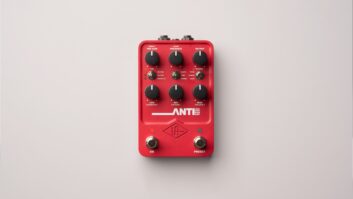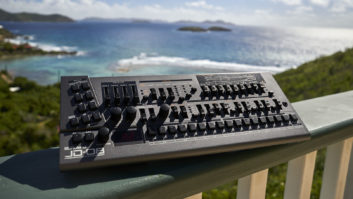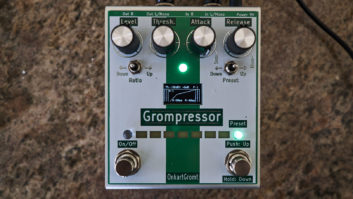
The JDX amplifier DI box sits between an amp and cabinet, allowing you to extract a line-level feed that emulates a speaker cabinet.
Radial Engineering has established itself as a manufacturer of high-quality, innovative products for audio and music. The company’s latest release, the JDX Reactor guitar amp DI box, is neither a re-amping device nor a traditional DI box. Placed between a guitar amplifier and its speaker cabinet, this little red box pulls a direct microphone feed by filtering both the amplifier’s output and the electro-magnetic “back” impulse from the speakers. The emulation is designed to be a compromise between a closed-back 4×12 and an open-back 2×12 cabinet. The idea is that a signal taken directly from the output of the amplifier will eliminate irregularities caused by different mic placements and varying acoustics.
How’s Your Doppelganger?
Having been a longtime fan of Radial products but a fairly staunch opponent of amp/cabinet emulators, I approached the Radial JDX with cautious optimism. During the course of a few weeks, I tested the JDX with a couple of different guitar rigs. Mixing on a Digidesign VENUE through a finely tuned Meyer MILO rig provided the perfect test for this little red box.
First up was a Divided By 13 head and a cabinet loaded with Celestion Greenbacks. The cab was also miked with a Shure 57 for comparison. I was immediately impressed. The sound was very natural and not unlike a microphone. However, I was sure that listening to the 57 would expose the emulator’s flaws. Much to my surprise, when I muted the Radial and brought up the mic, the sound was not that different. There were tonal distinctions, but overall they were very comparable. The JDX was bigger through the low mids and a touch darker on the top end. The emulation was also a bit tighter than the mic; all of this seemed to favor the dense, modern-rock tones that were being played.
When the guitarist would really dig in, the JDX likewise responded differently. While the speakers would compress and thin out to some degree as they were driven harder, the Radial maintained the low end and depth. Depending on the situation, this could be considered a pro or a con, but in this mix it was beneficial.
I also used the JDX on a Vox AC-30HH, again with a 57 on the cabinet. This guitar player had a more vintage-oriented tone. His sound was significantly brighter and less focused than the Divided By 13. While the JDX created a nice sound, it wasn’t as faithful as it had been on the Divided by 13. The JDX didn’t capture all the top-end details that the mic was picking up, particularly in solos or big overdriven chords. This is not to say it was unusable, but in this case, it wasn’t similar enough to blend with the mic, nor was it preferable.
Reactor Reactions
Overall, the JDX does an admirable job emulating guitar cabs. Although it’s not a replacement for miking, it can be very useful both by itself or paired with a microphone. The JDX’s powerful, focused sound would be right at home in most pop or modern rock mixes. I also found it to be particularly effective when mixing in-ear monitors. Putting the JDX between a guitarist’s favorite head and a load box would be a great way to lower stage volume (and much more natural sounding than a digital amp simulator). What’s not to like? The JDX is simple and well-constructed, and it works. It would be great if there were another emulation that modeled a smaller, brighter speaker set. Although it’s intended to emulate a compromise between a closed 4×12 and an open-back 2×12, it definitely tends toward the bigger, darker configuration. It should be noted that the JDX doesn’t provide any loading itself and must be connected to a speaker cabinet or load box.
Matt Bishop makes his debut as a Mix reviewer in this issue. He is a staff engineer at Alford Media Services in Dallas, where he mixes for a variety of local and national artists and churches.








